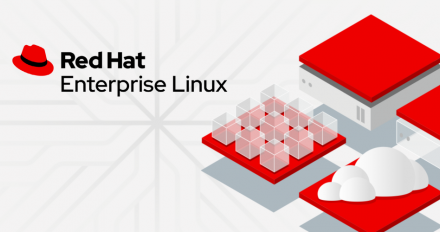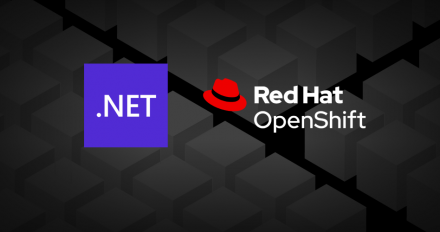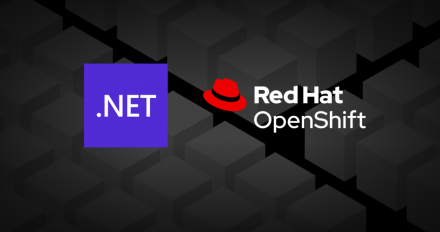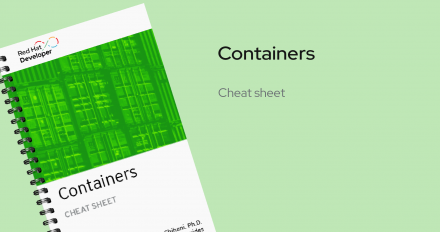
Build your first Python application in a Linux container
Get started with running Python 3.9 in containers. This quick tutorial guides you through building a Python web service on Red Hat Enterprise Linux 8.

Get started with running Python 3.9 in containers. This quick tutorial guides you through building a Python web service on Red Hat Enterprise Linux 8.

Catch up on changes to RHEL 8.4 from previous releases, including enhanced databases, application runtimes, and containers for cloud and edge computing.

Get a high-level overview of Linux containers and .NET Core, then see a couple of ways to build and containerize .NET Core applications for Red Hat OpenShift.

Developers looking to containerize .NET applications have options. Get an overview of the three paths forward using Linux, Windows, or Red Hat OpenShift CNV.

Get started with an introduction to container architecture including engine, image, registry, volume, related commands.

In this session, Diógenes gives an introduction of the basic concepts that make OpenShift, giving special attention to its relationship with Linux containers and Kubernetes.

Scott McCarty shares how containers can help in the DevOps world, but pay attention to 3 items.

Hugo delivered this lightning talk at Red Hat Summit 2017 and explains containers and the Red Hat container certification services for Red Hat software partners.

Hear from Don Schenk, Director of Developer Experience, Red Hat and Scott Hunter, Microsoft in this breakout session at Red Hat Summit 2017. In this session, we’ll show the evolution from a .NET application running on a server to a microservices architecture with zero-downtime deployments—including advanced techniques for optimizing performance. Join this session if you’re ready to apply your .NET skills to microservices and Linux containers. https://www.redhat.com/en/summit/2017/agenda/session

Key features, themes, and objectives of Red Hat Enterprise Linux 6, in a talk delivered by Engineering Vice President Tim Burke. Find out what's new, what's improved, and what is most important in the newest release of the Red Hat operating system.

The Linux container technology in Red Hat Enterprise Linux now combines resource management, process isolation, and file system separation. Docker uses the Linux container capabilities to provide standardization, ease of use, and portability. See a demo of how to set up multiple containers, deploying an assortment of workloads, and measuring the performance impact of running them at the same time using prototype user interface.

Red Hat® Enterprise Linux® Atomic Host is a small footprint kernel optimized for running containers. This video demonstrates the deployment of an HPC application (Linpack) across multiple environments and discusses the benefits of running HPC applications in containers.

The Linux container technology in Red Hat Enterprise Linux now combines resource management, process isolation, and file system separation. Docker uses the Linux container capabilities to provide standardization, ease of use, and portability. See a demo of how to set up multiple containers, deploying an assortment of workloads, and measuring the performance impact of running them at the same time using prototype user interface.

Red Hat® JBoss® Enterprise Application Platform (EAP) allows you to quickly deploy JavaEE-compliant applications on top of Red Hat Enterprise Linux. By utilizing Linux containers you can create a consistent environment for running EAP that will include all necessary application dependencies, like OpenJDK and any Java applications that you need to deploy or distribute. This demonstration provides step-by-step instructions on how to set up such configurations.

Putting technology in front of a wide audience quickly is part of the open source model, as seen in the 'release early, release often' mantra popular among open source developers. This community collaboration results in more feedback about feature functionality, and more opportunities for developers to continually improve code. Red Hat participates in this process as part of the Fedora community, and its contributions to Fedora help enhance the technology selected by Fedora's substantial user and contributor base. Fedora and Red Hat create a more scalable, extensible, and interoperable Red Hat Enterprise Linux. Read more: http://press.redhat.com/2010/10/21/fedora-14-reflects-evolution-of-leading-edge-open-source/

This is a demonstration of Oracle databases being deployed with Red Hat Enterprise Linux using Linux containers. The demo also goes into comparing container deployments to more traditional bare-metal and virtual machine deployment scenario and discusses the benefits. See how Red Hat Enterprise Linux enables your database environments to stay both flexible and current by utilizing Linux container technologies for deploying Oracle 11gR2 on RHEL 6, Oracle 12c on RHEL 6, and Oracle 12c on RHEL 7.

Senior Software Maintenance Engineer Neil Horman from Red Hat demonstrates cgroups, a generic mechanism the kernel provides for grouping of processes and applying controls to those groups. The grouping is done via a virtual filesystem called 'cgroup.' Within this filesytem, each directory defines a new group. Tunables within a cgroup are provided by what the kernel calls 'controllers.' Each controller is able to expose one or more tunable or control. When mounting the cgroups filesystem, it is possible to mount the filesystem several times, with each mount point having a different set of (non-overlapping) controllers. The key idea is that this allows the administrator to construct differing group hierarchies for different sets of controllers/tunables, which offers new ways to control and manage cloud resources. See what else is new in Red Hat Enterprise Linux 6: http://www.redhat.com/rhel/server/details/

Mission-critical RAS capabilities on Intel hardware. Applications that run best on Red Hat Enterprise Linux. Scalability, flexibility, reliability. All these factors contribute to the highest levels of performance made possible with Red Hat Enterprise Linux 6. Hear our partners--IBM, HP, Dell, BMC, and more--explain why.

Mike McGrath, a cloud architect at Red Hat, speaks about the OpenShift project, including express--a way to easily on-board PHP, Ruby, and Python applications via standard, open interfaces. McGrath demonstrates the process of uploading and updating the applications in the cloud using express, as well as ways to snapshot, clean up, and remove applications that are being migrated or eliminated. Learn more about Red Hat OpenShift: http://openshift.redhat.com/app/ Learn more about Red Hat cloud technology: http://www.redhat.com/cloud/build/

Companies around the world are turning to the Cisco Unified Computing System (Cisco UCS) and Red Hat Enterprise Linux OpenStack Platform to simplify the process of building cloud infrastructure. Learn how these two leading companies are paving way to an open cloud. Learn more about Red Hat Enterprise Linux OpenStack Platform: www.redhat.com/openstack

Adobe Systems, a long-time user of Red Hat® Enterprise Linux®, wanted to offer its enterprise customers easy access to sandbox resources to evaluate and prototype solutions using Adobe products. Turning to the cloud, Adobe used Red Hat Enterprise Linux and Amazon Web Services (AWS) to not only deliver a sandbox solution, but also to offer customers a Software- as-a-Service (SaaS) option for deploying Adobe-based solutions. Today, Adobe is using the Red Hat platform and Amazon Web Services to help customers simplify deployment, lower cost of ownership, and accelerate time to value.

Ever wonder how great features make it from the community into enterprise-ready technology like Red Hat(R) Enterprise Linu(R)? Fedora Project Leader Paul Friends explains how projects started upstream gain in popularity and maturity, are hardened and tested, and eventually make their way to enterprise solutions. Learn more about the Fedora Project: http://fedoraproject.org/

Isaac Roth from Red Hat discusses the way developers can use OpenShift flex to self-service deploy applications in minutes, choose and manage operating environments, and share and monitor information and functionality. Watch as Roth demonstrates OpenShift actions, deployments, and measures through the management interface. Learn more about Red Hat OpenShift: http://openshift.redhat.com/app/ Learn more about Red Hat cloud technology: http://www.redhat.com/cloud/build/

A private company with approximately 140 employees, Appcelerator worked closely with Red Hat on their flagship platform, Titanium. One of the leading enterprise-grade, cross-platform development solutions on the market, Titanium counts more than 300,000 mobile developers in its worldwide ecosystem. Appcelerator integrated Red Hat's OpenShift PaaS into its Titanium platform, enabling developers to push and auto-scale the backend of their mobile development processes. This integration gives Titanium developers the ability to create, deploy, and manage their mobile applications, and then push these applications to Red Hat's OpenShift PaaS with just a single click.

Hear directly from Red Hat(R) OpenShift customers and users--CEOs from BitRock, eXo, and Contendo, the EVP of products and technologies at 10gen, the director of Mayflower GmBH, and an information manager at FARO, as well as the CTO and co-founder of Appcelerator. They've all chosen Red Hat OpenShift to simply, easily, and affordably develop, deploy, and manage their enterprise PaaS architecture. The flexibility and open APIs of the Red Hat stack make moving into the cloud simple and sustainable--no matter your line of business or level of expertise. Learn more about Red Hat OpenShift: http://openshift.redhat.com/app/ Learn more about Red Hat cloud technology: http://www.redhat.com/cloud/build/